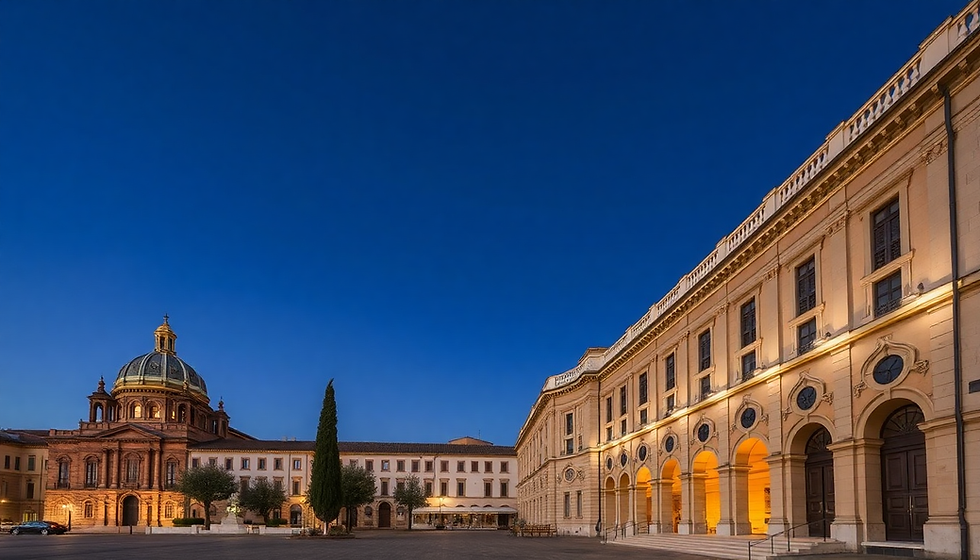Transforming Historic Italian Buildings Into Vibrant Contemporary Spaces
- Phase Zero
- Nov 14
- 4 min read
Across Italy, historic buildings that once served specific purposes—cinemas, warehouses, industrial facilities—are being reimagined as contemporary cultural and commercial spaces. This trend toward adaptive reuse represents one of the most exciting developments in heritage restoration, combining preservation with innovation to create vibrant, functional spaces for modern life. Rather than allowing historic structures to deteriorate or demolishing them for new construction, adaptive reuse projects breathe new life into these buildings while maintaining their architectural character. For designers and architects, adaptive reuse offers an opportunity to create unique, culturally significant spaces that serve contemporary needs while honoring their heritage.
The Rise of Adaptive Reuse in Italy
Italy's rich architectural heritage includes countless buildings that no longer serve their original purposes. The Odeon cinema in Milan, once a beloved entertainment venue, is being transformed into an experience center that celebrates cinema history while serving contemporary audiences. The Maestoso cinema has been reimagined as a sports venue, combining historic architecture with modern athletic facilities. The Mas warehouses in Rome now house the prestigious Accademia Costume & Moda, transforming industrial spaces into cultural institutions. These projects demonstrate that historic buildings possess inherent value and potential beyond their original functions, and that thoughtful adaptation can create spaces of significant cultural and economic value.

Balancing Preservation with Contemporary Functionality
The success of adaptive reuse projects lies in their ability to balance preservation with contemporary functionality. This requires a nuanced understanding of both the building's historical significance and the needs of its new use. A cinema converted into a retail space must maintain the grandeur and character of its original architecture while creating an environment that serves modern commerce. A warehouse transformed into a cultural institution must preserve its industrial character while providing the infrastructure necessary for exhibitions, events, and public engagement. This balance is achieved through careful planning, creative design, and a commitment to respecting the building's heritage while meeting contemporary requirements.
Case Study: The Odeon Cinema, Milan
The transformation of Milan's Odeon cinema exemplifies successful adaptive reuse. Originally designed as a grand entertainment venue, the Odeon featured ornate interiors, soaring ceilings, and architectural details reflecting early 20th-century elegance. Rather than demolishing this historic structure or attempting to restore it to its original function, designers recognized its potential as an experience center celebrating cinema history and contemporary media culture. The project preserved the building's iconic facade and interior architectural elements while introducing modern exhibition spaces, interactive displays, and contemporary amenities. The result is a space that honors its heritage while serving as a vibrant cultural destination for contemporary audiences.

Economic and Cultural Benefits
Adaptive reuse projects generate significant economic and cultural benefits for communities. By preserving existing structures, these projects reduce construction waste and environmental impact compared to demolition and new construction. They often attract investment and tourism, revitalizing neighborhoods and creating employment opportunities. Culturally, adaptive reuse projects celebrate and preserve architectural heritage while demonstrating that historic buildings remain relevant and valuable. They create unique spaces that cannot be replicated in new construction, offering distinctive environments for retail, dining, cultural activities, and community engagement.
Design Considerations for Adaptive Reuse
Successful adaptive reuse requires careful attention to several design considerations. First, the building's original architectural character must be respected and preserved, with new interventions designed to complement rather than compete with historic elements. Second, modern infrastructure—electrical systems, plumbing, climate control, accessibility features—must be integrated seamlessly without compromising the building's integrity. Third, the new use must be compatible with the building's structure and character; a cinema's soaring ceilings and grand spaces, for instance, lend themselves well to retail or cultural uses but may require significant modification for residential conversion. Finally, lighting, color, and material selections should create a cohesive design that bridges historical and contemporary aesthetics.
Sustainability and Adaptive Reuse
From a sustainability perspective, adaptive reuse is inherently more environmentally responsible than demolition and new construction. Preserving existing structures reduces embodied carbon, minimizes construction waste, and maintains the cultural and historical value embedded in buildings. Modern energy-efficient systems can be integrated into historic buildings, improving their environmental performance without compromising their character. This alignment between heritage preservation and environmental responsibility makes adaptive reuse an increasingly attractive option for developers, designers, and communities committed to sustainable development.
The Future of Adaptive Reuse in Italy
As Italy continues to grapple with the challenge of preserving its vast architectural heritage while meeting contemporary needs, adaptive reuse will likely play an increasingly important role. Government incentives for renovation, growing awareness of sustainability issues, and recognition of the cultural value of historic buildings all support this trend. For designers and architects, adaptive reuse projects offer opportunities to create distinctive, meaningful spaces that contribute to cultural preservation while serving contemporary purposes. These projects demonstrate that heritage and innovation are not opposing forces but can be integrated to create vibrant, sustainable communities.
Conclusion
Adaptive reuse represents a mature, sophisticated approach to heritage preservation that transforms historic buildings into vibrant contemporary spaces. By respecting architectural character while introducing modern functionality, adaptive reuse projects create unique environments that serve contemporary needs while honoring cultural heritage. The success of projects like Milan's Odeon cinema and Rome's Mas warehouses demonstrates that historic buildings possess enduring value and potential. For designers and architects committed to both innovation and preservation, adaptive reuse offers a compelling framework for creating spaces that are culturally significant, economically viable, and environmentally responsible. As we face the dual challenges of preserving our architectural heritage and creating sustainable communities, adaptive reuse stands as a proven methodology for achieving both objectives.



